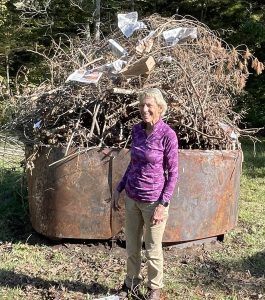Capitol Conservation District Loans Kilns for Biochar Production
Sally Shepherd threw the last of some old branches atop a pile of other yard waste inside what appeared to be an oversized barrel. She had gathered mostly woody waste material from her farm outside of Sissonville and was preparing to use it to create biochar, a super charcoal made by burning any biomass in an oxygen-starved environment.
Biochar is a potent soil amendment due to its high carbon content, pH, stability, porosity, and surface area.
The large barrel was one of two transportable kilns owned by Capitol Conservation District (CCD). Shepherd, a board member of CCD, obtained the two 8-foot diameter kilns for CCD through a grant from the Natural Resource Conservation Service and West Virginia Conservation Agency. Partnering with CCD for the grant, West Virginia State University (WVSU) is providing research and testing of the biochar. In Charleston, Manna Meal plans to try a burn in its half-acre garden, which provides fresh vegetables for meals for the homeless.
Shepherd would like to see the kilns borrowed by landscapers and farmers as a way to get rid of unwanted organic material, rather than sending it to the landfill, where it produces methane gas as it decomposes.
The kiln is composed of double rings of metal, which sit on the ground and deter air from being sucked into the fire, explained Dr. Amir Hass, an associate research professor at WVSU. “The material burning doesn’t get much air, so the heat radiates down, burning the material from the top to the bottom. It’s a more intense, more efficient burn than simply burning a pile outdoors.”
Pyrolysis, or thermal burning, retains carbon in the remaining char. At the end of the burn (about two hours), Hass doused the char with about 400 gallons of water to lock in the carbon.
Although any organic material can be used for a burn, it is important for the material to be dry. “Farmers and landscapers could stockpile their waste and allow it to dry out. Then they could use one of our kilns to burn it and create biochar,” Shepherd said. The biochar could be used in landscaping job or sold to customers as a soil amendment.
Biochar must be inoculated or activated before it is added to soil. Without an infusion of nutrients through activation, biochar will actually steal nutrient from soil. There are many recommendations for activation including:
- Soaking biochar in a dilute solution of liquid fertilizer 1-3 days before use;
- Adding biochar to a compost heap and allow 6-12 weeks;
- Steeping it in worm tea or compost tea;
- Mixing biochar into soil six months before planting;
- Steeping biochar in urine – Shepherd spreads the char on the floor of her horse stables, where it mixes with equine urine and manure to create inoculated biochar.
For more information or to borrow a kiln, contact Sally Shepherd at 304-545-3145 or .


